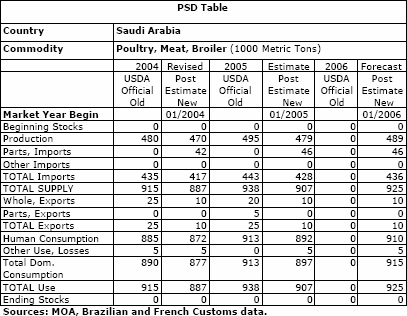



Saudi Arabia Poultry and Products Semi-Annual Overview - January 2006
By the USDA, Foreign Agricultural Service - This article provides the poultry industry data from the USDA FAS Poultry and Products Semi-Annual 2006 report for Saudi Arabia. A link to the full report is also provided. The full report includes all the tabular data which we have ommited from this article.Report Highlights:
In calendar year 2006, Saudi Arabia’s poultry meat production is forecast to reach 490,000 metric tons (MT), an increase of 2 percent compared to the expected 2005 level of 480,000 metric tons. Poultry meat imports for 2006 are expected to reach about 440,000 MT, a two percent increase compared to the 2005 level.
Poultry Production
Saudi Arabian poultry production and import estimates for CY 2005 and CY 2006 remain
unchanged since our 2005 Poultry Annual report (GAIN Report number SA5014). In
calendar year 2006, the Kingdom’s poultry meat production (mainly broiler meat) is forecast
to reach 490,000 metric tons (mt), an increase of 2 percent compared to the expected 2005
level of 480,000 metric tons. According to the Ministry of Agriculture (MOA) and poultry
farmers, the expected increase is based on the continued expansion of existing producers,
and the expected operation of newly licensed poultry farms. Poultry meat imports for 2006
are expected to reach about 440,000 MT, a two percent increase compared to the current
year.

Frozen Broiler Meat Imports
The Saudi Arabian government’s decision to impose an import ban on Chinese poultry
products about two years ago and the continued appreciation of the euro compared to the
U.S. dollar have continued to bolster Brazilian frozen broiler meat exports to the Kingdom.
According to local importers, Brazilian frozen broiler meat exports this year are expected to
increase by at least 10 percent compared to the 2004 export level of 333,223 metric tons.
France, the second largest broiler meat exporter to the Kingdom, is expected to lose
significant market share to Brazil this year compared to last year. In 2004, France exported
82,981 metric tons of frozen broiler meat to the Kingdom.
The C&F prices of Brazilian frozen poultry meat exports to the Kingdom have begun to
decrease from high of $1,490 per MT in November 2005 (highest price ever reported) to
$1,450 mt in December 2005, a decrease of about 3 percent. The prices for French chickens
are similar to those for Brazilian birds. A further $30 to $50 decease in Brazilian broiler meat
prices is expected in January/February 2006 due to higher stocks of frozen meat available in
the Saudi market, contributing to a lower demand and increased offers by Brazilian exporters
to supply at more competitive rates. Major Saudi broiler meat importers claim that Brazilian
exporters are currently holding higher than normal stocks, which they want to reduce, due to
some difficulties they are facing in exporting to Iraq and Iran.
Ban on Live Poultry Imports
On November 12, 2005, the Saudi Arabian government imposed an import ban on live birds
from all countries to prevent any likelihood of importing live birds that might carry avian
influenza (AI). The ban, which was implemented immediately, does not include imports of
day-old chicks and hatching eggs that are produced in professionally supervised projects.
That means, U.S. exports of day old chicks and hatching eggs to Saudi Arabian, valued in
2003 at more than $4.2 million, will not be affected. No data are available for 2004 due to
an import ban in place at that time on live birds, baby chicks and hatching eggs.
The Saudi move is an apparent response to the November 2005 discovery of two birds in
Kuwait infected with bird flu. According to the Saudi Ministry of Agriculture’s (MOA) report, a
pet bird (falcon) imported from East Asia and a flamingo living in a private marine chalet in
Kuwait were tested positive for AI. In addition to banning imports of live birds, the decree
authorized the MOA to immediately destroy all live birds recently imported via any of the
Kingdom’s ports of entry.
Before issuing the recent decree, the Kingdom had on various occasions banned imports of
live poultry and poultry products from countries that reported cases of AI. Over the past two
years, the Kingdom has banned imports of live poultry and poultry products from the
following countries: China, Hong Kong, Vietnam, Thailand, Malaysia, Indonesia, Cambodia,
Laos, Kazakhstan, Mongolia, Japan, Turkey, Romania, South Korea, Pakistan, and Russia.
The MOA has intensified its monitoring activities of 500 poultry farms in various parts of the
Kingdom. The recent royal decree provided more than five million dollars to enable the MOA
to purchase standby incinerators for its 25 quarantine centers to immediately destroy any
imported live birds.
egg exports to Saudi Arabia for 2003

Note: no data is available for 2004 due to import ban in place at that time on live birds, baby chicks and hatching eggs.
List of Articles in this series
To view our complete list of 2006 Poultry and Products Semi-Annual reports, please click hereSource: USDA Foreign Agricultural Service - January 2006











